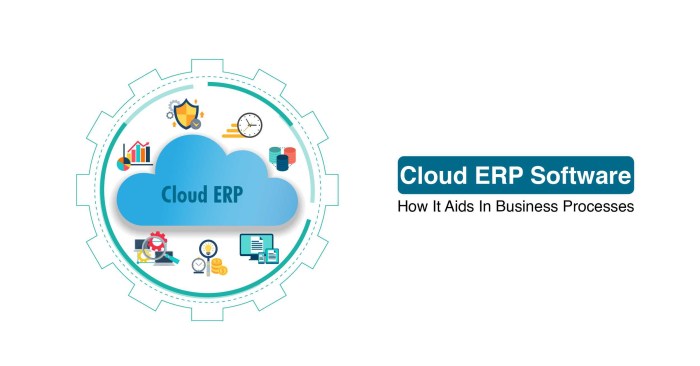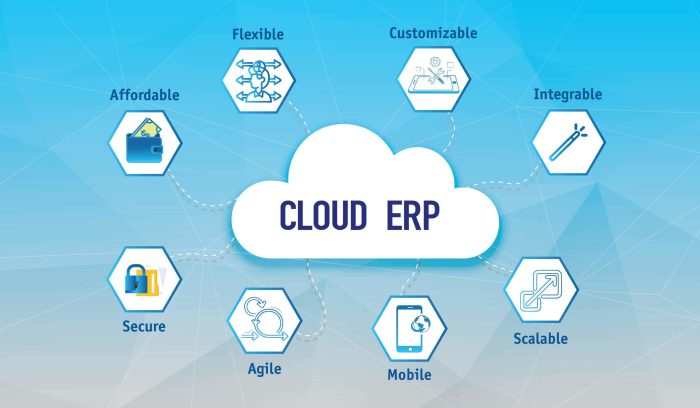The role of cloud-based ERP software in business growth is undeniable. As businesses increasingly embrace digital transformation, cloud-based ERP systems have emerged as a powerful tool for streamlining operations, enhancing efficiency, and unlocking new growth opportunities. These systems offer a flexible and scalable solution, allowing businesses to adapt to changing market demands and optimize their resources.
Cloud-based ERP software provides a comprehensive suite of integrated modules that cover all aspects of a business, from finance and human resources to supply chain management and customer relationship management. This integrated approach eliminates data silos, fosters collaboration, and provides real-time insights that drive informed decision-making.
Impact on Business Growth: The Role Of Cloud-based ERP Software In Business Growth

Cloud-based ERP software plays a pivotal role in propelling business growth by empowering organizations with enhanced data visibility, improved decision-making capabilities, and streamlined operations. This comprehensive system provides real-time insights into critical business processes, enabling companies to make informed decisions, optimize resource allocation, and ultimately drive sustainable growth.
Enhanced Data Visibility and Decision-Making
Cloud-based ERP systems offer a centralized platform for managing and analyzing data from various departments within an organization. This centralized repository provides a holistic view of operations, enabling businesses to identify trends, patterns, and potential areas for improvement. By consolidating data from different sources, ERP systems eliminate data silos, fostering a collaborative environment where teams can access and share information seamlessly.
This improved data visibility empowers organizations to make informed decisions based on accurate and real-time insights, leading to more effective resource allocation, optimized workflows, and ultimately, improved business outcomes.
Real-time Insights for Strategic Planning and Growth Initiatives
Cloud-based ERP systems generate real-time insights into key performance indicators (KPIs), allowing businesses to monitor progress, identify bottlenecks, and make necessary adjustments to achieve their strategic objectives. These insights provide a comprehensive understanding of the organization’s performance, enabling companies to develop data-driven strategies for growth. By analyzing real-time data, businesses can identify emerging trends, anticipate market changes, and proactively adjust their plans to stay ahead of the competition.
This data-driven approach to strategic planning allows companies to optimize resource allocation, enhance customer experience, and ultimately drive sustainable growth.
Examples of Business Growth Through Cloud-Based ERP
“By adopting a cloud-based ERP solution, [Company Name] experienced a 20% increase in sales within the first year. The system provided real-time visibility into inventory levels, allowing the company to optimize stock management and reduce lead times. This, in turn, enabled them to fulfill orders faster and meet customer demands more effectively.”
“Another example is [Company Name], a manufacturing company that leveraged a cloud-based ERP system to streamline its production processes. The system enabled them to track production progress in real-time, identify bottlenecks, and optimize resource allocation. This resulted in a 15% increase in production efficiency and a significant reduction in operational costs.”
Key Considerations for Implementation

Implementing a cloud-based ERP system is a significant undertaking that requires careful planning and execution. The success of your implementation depends on several factors, including choosing the right solution, effectively managing the transition, and maximizing the return on your investment.
Choosing the Right Cloud-Based ERP Solution
Selecting the right cloud-based ERP solution is crucial for your business’s success. It’s important to consider various factors that align with your specific needs and goals.
- Industry Fit: Different ERP solutions cater to specific industries, offering features and functionalities tailored to their unique requirements. For example, a manufacturing ERP solution will have different features than a retail ERP solution. Choosing a solution designed for your industry ensures that it meets your specific business needs.
- Scalability: As your business grows, your ERP system should be able to scale with it. Cloud-based ERP solutions offer flexibility in scaling resources up or down as needed, allowing you to adjust your system to handle increasing workloads and data volumes. Look for solutions that can accommodate your anticipated growth.
- Security: Data security is paramount, especially when relying on cloud-based systems. Choose a solution with robust security features, including data encryption, access controls, and regular security audits. Consider solutions that comply with industry-specific regulations and standards like HIPAA or GDPR.
- Integration: Your ERP system should integrate seamlessly with other existing business applications, such as CRM, accounting, and e-commerce platforms. This ensures data consistency and avoids redundant data entry. Look for solutions that offer pre-built integrations with your existing systems or have an open API for custom integrations.
- Cost: Cloud-based ERP solutions offer various pricing models, such as subscription-based or pay-as-you-go. Evaluate the cost of different solutions and compare them to your budget. Consider the long-term cost of ownership, including implementation, maintenance, and ongoing support.
Implementing a Cloud-Based ERP System
The implementation process for a cloud-based ERP system involves several key steps. Proper planning and execution are essential to ensure a smooth transition and minimize disruptions to your business operations.
- Data Migration: Migrating your existing data from your legacy system to the new cloud-based ERP solution is a critical step. This process requires careful planning and execution to ensure data accuracy and integrity. Consider using a data migration tool to automate the process and minimize potential errors.
- User Training: Providing adequate training to your users is essential for the successful adoption of the new ERP system. Offer comprehensive training programs that cover all aspects of the system, including navigation, functionalities, and reporting. Consider offering ongoing support and resources to help users with any questions or issues they may encounter.
- Testing and Go-Live: Before launching the new ERP system, conduct thorough testing to ensure it functions correctly and meets your business requirements. This includes testing data accuracy, system performance, and user workflows. Once the system is fully tested, you can plan your go-live date and implement the new system in a controlled manner.
Maximizing Return on Investment
Implementing a cloud-based ERP system is an investment in your business’s future. To maximize your return on investment, it’s essential to adopt best practices that optimize the system’s usage and value.
- Utilize System Features: Leverage the full range of features and functionalities offered by your cloud-based ERP system. This includes utilizing reporting and analytics tools to gain insights into your business performance, automating repetitive tasks, and streamlining workflows. By fully utilizing the system’s capabilities, you can maximize its value and achieve a greater return on your investment.
- Continuous Improvement: Cloud-based ERP systems are constantly evolving, with new features and functionalities being added regularly. Stay updated on the latest enhancements and explore how they can be leveraged to improve your business processes. Regularly assess your system’s performance and identify areas for improvement to optimize its effectiveness and ensure it continues to meet your evolving needs.
- Seek Support: Your cloud-based ERP vendor typically provides ongoing support and resources to help you with system implementation, maintenance, and troubleshooting. Take advantage of these resources to ensure you’re getting the most out of your system and to address any issues promptly. Consider engaging with the vendor’s community forum or online resources to learn from other users and share best practices.
Future Trends in Cloud-Based ERP

Cloud-based ERP systems are constantly evolving, driven by advancements in technology and the changing needs of businesses. The future of cloud-based ERP is bright, with several emerging technologies poised to transform how businesses operate and grow.
Impact of Emerging Technologies on Cloud-Based ERP, The role of cloud-based ERP software in business growth
The integration of emerging technologies like artificial intelligence (AI) and machine learning (ML) is revolutionizing cloud-based ERP systems, leading to enhanced efficiency, improved decision-making, and greater agility.
- AI-Powered Automation: AI can automate repetitive tasks, freeing up human resources for more strategic initiatives. For example, AI-powered chatbots can handle customer inquiries, while AI-driven process automation can streamline routine tasks like data entry and invoice processing.
- Predictive Analytics: ML algorithms can analyze historical data to identify patterns and predict future trends. This capability enables businesses to make informed decisions regarding inventory management, demand forecasting, and resource allocation. For instance, an ERP system powered by ML can predict potential supply chain disruptions and recommend preventive measures.
- Personalized User Experiences: AI can personalize user experiences by tailoring dashboards and reports to individual user preferences and roles. This personalized approach can enhance user engagement and productivity.
- Enhanced Security: AI-powered security systems can detect and prevent cyber threats in real-time, safeguarding sensitive business data.
The Future Role of Cloud-Based ERP in Shaping the Digital Landscape
Cloud-based ERP systems are increasingly becoming the backbone of digital transformation initiatives.
- Integration with Other Digital Technologies: Cloud-based ERP systems are seamlessly integrating with other digital technologies like the Internet of Things (IoT), blockchain, and cloud computing platforms. This integration enables businesses to collect and analyze data from various sources, gain real-time insights, and optimize operations across the entire value chain.
- Enabling a Connected Ecosystem: Cloud-based ERP systems facilitate collaboration and communication among various stakeholders, including employees, customers, and partners. This connected ecosystem fosters transparency, agility, and efficiency.
- Driving Innovation and Growth: By leveraging emerging technologies, cloud-based ERP systems empower businesses to innovate, adapt to changing market conditions, and drive sustainable growth.
In conclusion, cloud-based ERP software is a game-changer for businesses seeking to achieve sustainable growth. By embracing the power of cloud technology, businesses can leverage advanced functionalities, gain access to real-time data, and automate processes to unlock new levels of efficiency and innovation. As the digital landscape continues to evolve, cloud-based ERP systems will play an increasingly pivotal role in shaping the future of business operations.
General Inquiries
What are the key benefits of cloud-based ERP?
Cloud-based ERP offers several benefits, including scalability, affordability, accessibility, and enhanced security. It also eliminates the need for costly on-premises infrastructure and provides access to regular updates and new features.
How can I choose the right cloud-based ERP solution for my business?
Choosing the right cloud-based ERP solution involves considering factors such as industry fit, scalability, security, integration capabilities, and user experience. It’s essential to evaluate the vendor’s reputation, customer support, and pricing models.
What are the potential challenges of implementing cloud-based ERP?
Implementing cloud-based ERP can present challenges, such as data migration, user training, and integration with existing systems. It’s crucial to have a clear implementation plan, adequate resources, and strong stakeholder buy-in.